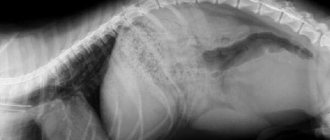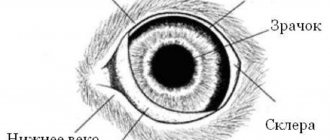Dog food
Most dog breeders prefer to feed Shar Peis with natural products, since representatives of this breed are prone to food allergies, and food in pet stores is often a source of it. If you decide to feed your four-legged friend natural food, then you must be aware that preparing the dishes will take quite a lot of time.
The most important thing to remember: you should absolutely not feed your pet food from your table . What a person eats is completely unsuitable for a purebred dog. What should the diet of dogs of this breed consist of?
- lean meat. This is the basis of Shar Pei nutrition and a source of protein. It is preferable to feed the dog chicken, turkey (wings, necks, breast, liver and heart). It is allowed to feed beef (muscle part or head trimmings), as well as lamb and rabbit meat,
- offal should make up about 50% of the daily meat intake. This category includes kidneys, cow udders, heart, lungs, trachea, cartilage, ears,
- Eggs should be given raw. 1-2 pieces per week is enough,
- It is recommended to choose low-fat varieties of fish: hake, halibut, cod, pink salmon, haddock, etc. The exception is perch and mackerel,
- It is recommended to give vegetables and fruits in ground form so that the stomach can digest them better. The menu should include broccoli, apples, zucchini, and carrots. It is acceptable to give some beets and tomatoes,
- Fermented milk products can only be included in the menu if the pet does not have lactose intolerance. The permissible dose is 1 time per week. You need to give milk carefully, in small portions, to monitor the reaction to this product. Dairy products should be low-fat
- cereals: rice, buckwheat and oatmeal. Typically, boiled porridge with water is introduced into the diet only if the dog does not weigh enough for its age,
- The daily menu must include vitamins and probiotics.
How do allergies manifest in Shar Pei?
Due to their small size, Shar Pei's allergy symptoms usually appear quickly, ranging from a few minutes to several weeks. The strength of side effects may vary depending on the duration of contact with the allergen and the state of the pet's immunity. Allergies in Shar Pei are manifested by the following symptoms:
- Itchy skin. The Shar Pei begins to itch a lot, resulting in redness of the skin. Such symptoms are also typical for dermatological problems.
- Dry skin and increased dandruff. A sure sign of food allergy, but can also be confused with dermatitis.
- Alopecia areata (baldness). It can develop as a result of internal processes in the body during allergies. In addition, bald spots can appear due to the fact that the dog is constantly itching.
- Sweet cloying odor from skin, fur and mouth. The smell becomes especially unpleasant when allergic processes are advanced.
- Sputum in the armpits, chest, dewlap (looks like increased sweating). A sign of a severe allergic reaction and the development of eczema.
- The pet begins to scratch and shake its ears frequently. Ear problems are accompanied by the appearance of a large amount of discharge and the formation of open wounds. Allergic otitis often occurs in sharpeis due to food allergies.
- Increased tearing of the eyes. The eyes become cloudy and wet, and yellow-greenish mucus constantly accumulates in the corners.
The presence of one of the signs is a reason to contact a veterinarian for an accurate diagnosis. If a Shar Pei has several of the above symptoms, we can assume with 99% certainty that it is an allergy.
Other dog diseases may exhibit similar symptoms; an accurate diagnosis and treatment should be prescribed by a qualified veterinarian.
Actions in case of allergies
The first thing to do if you have a food allergy is to identify the allergenic product and eliminate it from your diet. It is worth considering that the principles of feeding for food allergies depend on what the dog eats: dry food or natural food.
Let's consider two options for feeding during illness.
When feeding dry food
From the menu you need to exclude everything that the dog ate before the onset of the disease. The main dish for the coming weeks should be boiled rice with olive oil . Vitamins C, E and vitamin B complex should be added to the feed.
As soon as your pet gets better, you can gradually add carrot puree, boiled cabbage, ground lettuce or parsley to the food.
At the next stage, you need to switch to dry food again. It should be hypoallergenic with a low protein content (14 to 22%).
When feeding with natural products
You need to remove all products from the menu except chicken wings and necks . If it turns out that chicken has become an allergenic product, then for the first two weeks your pet’s menu should include meat that you have never given it. However, allergies to chicken meat are extremely rare, so raw poultry meat is considered the most suitable food during the period of illness.
Just as in the first principle of feeding, vitamins C, E and B should be added to the diet.
As soon as the symptoms subside, you can add a raw egg, herbs, vegetables, heart, liver and ground fish to the menu.
When expanding the diet, you should not give everything at once and in large quantities. Try one product first, then another on the second day. This way you can observe your pet’s reaction.
Causes of allergic reactions
In a normal state, the animal body is able to distinguish between external substances that are necessary for normal functioning and harmful foreign substances. Allergic Shar-Peis lack this ability and the body begins to fight even neutral or beneficial substances. The cause of a negative reaction of the body can be any external allergens; they can be divided into several categories:
- Food allergies. Shar-Peis most often experience reactions to chicken meat and eggs, flavorings and dyes of artificial food.
- Seasonal flowering plants. These can be indoor (geranium, fern, crinum, oleander) or outdoor plants (alder, hazel, birch, willow, cereals, wormwood, sorrel).
- Medications. Can occur with any medication, but the allergy disappears after stopping use.
- Care products for Shar Pei and its clothing. Chemical allergies are quite common and can be caused by wool shampoo, balm, or powder used to wash a dog’s clothes.
- Insect bites and viruses, bacteria and parasites that enter the body in this way. Reactions to such allergens are clearly expressed by severe swelling in the bite area, but within 2-3 days the symptoms usually subside.
In approximately 60% of cases, allergies in Shar-Peis develop due to allergens in the food. 20% comes from drugs and chemicals and 20% from all other possible external agents.
It happens when a dog’s body produces an allergen itself and begins to fight it, they are called autoallergens.
What not to eat
Under no circumstances should you give your Shar Pei the following foods:
- milk and butter,
- bones,
- pasta,
- fish roe,
- river fish,
- wheat and corn grits,
- pork and lamb,
- sausages and sausages,
- chocolate,
- honey,
- sweets and bread,
- spicy, salty, pickled, smoked and fried foods.
All of these foods may cause your pet to have an upset stomach or allergies.
What to do about Shar Pei allergies
It is impossible to completely cure allergies in a Shar Pei, like in any other dog. Therapy for allergic manifestations is aimed at:
- Treatment of symptoms of allergic reactions;
- Removing the allergen from the pet’s body;
- Eliminating the allergen from the animal’s environment;
First of all, you need to eliminate unpleasant allergy symptoms. For all types and causes of such reactions, antihistamines are prescribed, such as Suprastin, Tavegil, Diphenhydramine. The dosage is determined depending on the age and body weight of the Shar Pei. For example, for a 4-month-old puppy, half a tablet of Suprastin 2 times a day is enough, and for an adult Shar Pei you need to give a whole tablet 2-3 times a day.
For inflamed areas of the skin after severe scratching, special wound healing and anti-inflammatory ointments are prescribed.
It may take a month for the Shar Pei to remove the allergen from its body. In this case, adsorbents are prescribed, the most common is activated carbon. For a Shar Pei, three tablets twice a day are enough; a puppy is prescribed a smaller dose. The simultaneous use of antihistamines and adsorbents is prohibited; it is best to give the former 2 hours before taking the latter.
Eliminating allergens from the dog’s environment is the most difficult stage. Treatment depends on the cause of the allergic reactions. If the problem is insects, you need to remove them from the Shar Pei’s fur; allergies from plants can only be eliminated by limiting walks with the dog during the seasonal flowering period of such plants. Food allergies can be triggered by any component of the diet. It is necessary to conduct tests to identify the allergen in food and eliminate it.
Nutrition for puppies 1-5 months
The first food of a small Shar Pei is milk. In the second month, most of the diet should be adult food. However, it is not worth completely weaning off the mother’s milk, since with it the puppy receives the microelements and vitamins necessary for growth and development.
>It is recommended to feed puppies from 1.5 to 2 months at least 6 times. Up to 3 months – 5 times, from 3 to 5 months – 4 times. From six months to a year – 3 times. A one-year-old puppy can be switched to two meals a day.
If you give dry food, then it needs to be soaked in warm water. Experienced dog breeders recommend feeding premium food for at least a year.
If you feed natural food, then you should adhere to the following standards: 70% of the diet should be raw meat and offal, 30% vegetables, fruits, eggs and dairy products.
First symptoms of diseases and methods of treatment
The Shar Pei is a strong, active and playful dog, very sociable and friendly. Like other breeds, the animal suffers from external and internal parasites, but there are a number of pathologies to which Shar-Peis have a natural predisposition - dermatological and allergic diseases, infectious diseases of the eyes, ears, problems with the digestive, respiratory and immune systems.
If a Shar Pei is sick, he is not happy, he immediately becomes lethargic, looks for places for solitude, his playfulness disappears, and the pet does not eat. If the animal exhibits changes in behavior, you need to carefully examine the folds, ears and eyes, and measure the temperature.
Ears hurt
According to the standard, Shar-Peis should have hard, triangular-shaped ears that fit tightly to the head - this feature causes the development of various ear diseases.
Main diseases:
- pityrosporosis - active growth of yeast fungi in the ear canal;
- hyperplastic otitis media is a consequence of chronic inflammation of the middle ear; skin hyperplasia in the form of a wart can be seen in the upper part of the ear canal; treatment is carried out surgically;
- stenosis is a pathological narrowing of the ear canal that requires surgery.
Ear diseases manifest themselves in the form of purulent or other discharge from the ear canal, the animal often shakes its head and scratches its ears. First aid is to drop Otinum and Otipax into the ears. For otitis media, make small cotton pads, soak them in Yoddicerin solution, place them in the ear canal for 10 minutes, and carry out the procedure in the evening for 5–7 days.
In Shar-Peis, ear problems often occur due to food allergies.
Eyes hurt
The main problem with Shar-Peis is eye disease, in most cases surgical intervention is required. The most common diagnosis is entropion - entropion of the upper or lower eyelid. Signs: lacrimation, copious discharge of a purulent nature, redness of the eyes, the animal constantly squints its eyes. Treatment: eyelid surgery. The operation will have to be performed several times as the pet grows. Other ophthalmological problems in Shar Peis include glaucoma, retinal dysplasia, and prolapse of the third eyelid gland.
Skin diseases
Due to the large number of folds, the skin constantly rubs and gets injured, which provokes the appearance of diaper rash and increased activity of the sebaceous glands. As a result, the animal develops intertrigo - a bacterial or fungal pathology of an inflammatory nature.
Idiopathic mucinosis - can occur in 2 forms. In the subcutaneous form, mucin accumulates in folds, damaged skin swells and becomes dense. With vesicular, numerous small pimples form on the lower lip, buttocks, and between the toes. They have a sticky liquid inside, the animal becomes itchy, they need to be lubricated with Chlorhexidine or brilliant green.
Treatment methods for mucinosis:
- In young dogs with primary mucinosis, observation by a veterinarian without special treatment is indicated. Often the pathology disappears on its own at the age of 2–5 years.
- In severe forms of the pathology, Prednisolone is prescribed for a month; usually one course is enough, but for some Shar Peis the therapy is carried out continuously, using small doses of the drug.
- At the same time, atopy, pyoderma, and fungal dermatitis are treated, since these pathologies contribute to the appearance of vesicles.
Demodicosis - a disease that develops when infected with intradermal mites, often develops against a background of weakened immunity. Signs: severe itching, bald spots and bald spots appear all over the body, and papules form. Without proper treatment, pyoderma and folliculitis develop, and the process of decay begins in the tissues. Therapy - Advocate drops externally on bald patches, ivermectin preparations in liquid form orally for at least 3-4 weeks. The effectiveness of treatment is determined by scraping.
Seborrhea - manifests itself in the form of severe peeling of the skin, crusts, numerous greasy scales, an unusual specific odor emanates from the animal, and the condition of the claws worsens. The disease is often hereditary and therefore appears in puppies at an early age. Often, against the background of seborrhea, complications of a fungal and bacterial nature occur. Treatment - special shampoos, antifungal and antibacterial drugs, nutritional supplements with Omega 3.6, Cortisone, vitamin A.
If necessary, use medicated shampoo. You first need to wash the animal with a regular cosmetic product, then treat it with a medicinal product; you need to keep it for at least a quarter of an hour.
Allergy
Allergies in Shar Peis almost always manifest themselves as skin symptoms, and are therefore closely related to dermatological problems. Additionally, the eyes become watery and nasal discharge appears.
Atopy is an allergic reaction to foreign protein compounds found in the environment or food. The pathology is often seasonal. The animal itches a lot, the skin turns red, and pustules appear on it due to the addition of bacterial infections. Most often, the disease is diagnosed in Shar Pei between the ages of six months and 7 years.
Allergic dermatitis - occurs upon contact with chemical elements of water, is characterized by itching, blistering, swelling of the skin, and sometimes you may notice that the nose is peeling. Dermatitis often occurs with severe flea infestation.
How to eliminate itching and other symptoms of skin diseases:
- Lubricating the inflamed areas with fresh aloe juice will help quickly eliminate all unpleasant sensations and speed up the regeneration process.
- Echinacea, comfrey, calendula - these plants have an immunomodulatory, anti-inflammatory, cooling effect. You can use herbs individually or prepare a collection by mixing all types of raw materials in equal quantities. Pour 1 liter of boiling water 4 tbsp. l. mixture, leave in a sealed container until cool, strain. Pour the infusion into a container with a spray bottle and spray on the affected skin.
- For weeping ulcers and eczema, prepare a mixture of equal parts of calendula inflorescences, comfrey leaves and echinacea. Add 100 g of red clay to 50 g of collection. Apply the composition to sterile gauze, make a bandage, or simply sprinkle the medicine on the affected area.
When treating skin diseases and allergies, digestive enzymes are prescribed - Mezim, Festal; as additional phyto-additives - Essiak tea with burdock root, a fermented product called Seacure, contains many peptides and amino acids that help reduce the risk of complications and promote detoxification of the body. For bacterial infections and purulent processes, antibiotics are prescribed.
Diarrhea
Stomach upset is a common problem in Shar-Peis. Their digestive system is very sensitive, diarrhea occurs when changing food, food allergies, due to the ingestion of inedible objects, against the background of helminthic infestations. The basis of treatment is diet therapy, drinking plenty of fluids, and enemas with chamomile decoction. You can give Catozal, sorbents, probiotics (Emprobio) Mezim and other enzymes, the antibiotic Lincomycin for diarrhea.
Among other gastrointestinal problems, Shar-Peis often develop congenital megaesophagus - it occurs in puppies immediately after finishing breastfeeding and is characterized by belching and a slow digestion process. In old age, dogs develop a special form of enteritis - intestinal inflammation, in which lymphocytes and plasma cells form the basis of the mucous membrane and cellular infiltrate.
Dangerous viral and fungal diseases - distemper, hepatitis, histoplasmosis - can provoke diarrhea in an animal.
Dry food
When choosing food, you need to carefully study the information on the packaging. The list of ingredients should not include corn, legumes, or wheat. The basis of food suitable for your pet should be meat . But don’t forget about vegetables: they must also be included in the composition. It is better to give your preference to premium food.
Undesirable ingredients in food:
- meat meal and animal fat,
- source of protein - offal,
- dyes,
- beet pulp,
- sweeteners.
Don't experiment with dry food. If your dog has been eating one brand of food for quite a long time, then you shouldn’t switch it to food from another brand, unless, of course, it feels good.
How to choose dry food
The first thing you need to pay attention to is the proportion of natural ingredients in the composition. Often, packaging contains vague information about herbal supplements. Such food, the composition of which looks very doubtful, is not worth buying. The more detailed the list of ingredients, the better and faster you can understand whether the food is suitable for your dog or not.
The packaging must indicate information about the passage of meat and fish through veterinary inspection . If there is no information about this, then it is not worth the risk of buying such food.
It is advisable to choose food without food additives, unfamiliar names of substances, preservatives and flavor enhancers.
Before giving food to your dog, smell it. A good fresh product should not emit an unpleasant pungent or chemical odor . The granules should generally be light brown in color. Many foods can be shiny. This indicates the presence of fat in them. But if fats are not listed in the composition, then this should alert you.
The packaging always contains information on feeding and number of servings. This information is advisory in nature and should not be followed, since each dog requires a different number and volume of portions.
When to change food
The health, activity and appearance of the dog depend on the quality of nutrition. If you notice any changes in your pet, then most likely it is due to an incorrect diet and unsuitable food . First of all, you should pay attention to the following changes:
- bad breath,
- lethargy,
- presence of large amounts of tartar,
- flatulence,
- constipation or diarrhea,
- discharge from the eyes,
- the dog started chewing its paws,
- ear odor, itching,
- fat six, excessive shedding.
All these signs indicate problems with the dog's health. If these symptoms occur, you should consult a veterinarian , as they can be either a consequence of poor nutrition or the result of a disease.
The most common diseases of Shar Pei dogs
A predisposition to a disease does not mean that every Shar Pei will have it. Closely monitor your pet's condition and activity. If you see something wrong in your pet's behavior, it is best to contact a veterinarian.
The following diseases are not common in the breed, but they can occur:
- Shar Peis are susceptible to certain diseases, especially skin diseases .
- Shar Pei fever . Also known as swollen hock syndrome (sometimes both joints) and results in reluctance to move, abdominal pain, vomiting, diarrhea and shallow breathing. In dogs, one or more bouts of unexplained fever with a high temperature usually begins at 18 months, but can occur when the dog is an adult. The fever lasts for 24 to 36 hours, and treatment includes reducing the fever and pain.
- Hypothyroidism . This is a disease of the thyroid gland. It is believed to be responsible for conditions such as epilepsy, hair loss, obesity, hyperpigmentation, pyoderma and other skin conditions. Treated with medications and diet.
- Cancer . Symptoms include abnormal swelling of the sore or lump, sores that do not heal, bleeding from any part of the body, and difficulty breathing. Treatment for cancer includes chemotherapy, surgery and medications.
- Elbow dysplasia . It is thought to be caused by abnormal growth and development, resulting in a weakened joint. The disease varies in severity: the dog may develop arthritis or become lame. Treatment includes surgery, weight control, medical supervision, and anti-inflammatory medications.
- Demodicosis . Caused by the demodex mite, which a mother dog passes to her puppies in the first few days of life. The tick cannot be transmitted to people or other dogs; only from mother to puppies. Demodex mites live in hair follicles and usually do not cause problems, but if your Shar Pei has a weakened or compromised immune system, he may develop demodicosis. In its localized form, patches of red, scaly, balding skin appear on the head, neck and forelimbs.
- Seborrhea . This is a condition characterized by peeling skin. This is usually a secondary condition to an allergy, infection, or other medical condition. Treatment includes bathing in a medicated shampoo and treating the underlying condition.
- Pyoderma . Another skin condition is a bacterial skin infection that is quite common in Shar-Peis. This may be a primary or secondary infection; the latter is the result of an underlying condition such as allergies or hypothyroidism. Pyoderma is treated with antibiotics.
- Knee dislocation . This is when the knee joint (often the back leg) slips inward, causing pain.
- Hip dysplasia . This is an inherited condition in which the hip bone does not fit tightly into the hip joint. In some dogs it causes pain and lameness in one or both back legs, but in other dogs it may not cause any discomfort. X-rays are the most accurate way to diagnose the problem.
- Gastric volvulus . This is a life-threatening condition that can affect large dogs with large chests. This is especially true if they eat one large meal a day, eat quickly, drink large volumes of water after meals, and exercise vigorously after meals. Bloat is more common in older dogs. The stomach is distended by gas or air and then twisted. The dog cannot burp or vomit to get rid of the excess air in the stomach, and the normal return of blood to the heart is difficult. Blood pressure drops and the dog goes into shock. Without immediate medical attention, the dog may die. Suspect bloat if your dog has a distended abdomen and is vomiting without vomiting.
- Cutaneous mucinosis . Mucin is a substance in the skin that causes wrinkles. Clear and sticky, it acts like glue when the dog is injured. However, some Shar-Peis have excess mucin, which causes clear blisters to form on the skin that can rupture and dry out.
- Glaucoma is defined by increased pressure in the eye and can be found in two forms: primary, which is hereditary, and secondary, which is caused by a decrease in fluid in the eye due to other eye diseases. Symptoms include vision loss and pain, and treatment and prognosis vary depending on the type. Glaucoma is treated with surgery or eye drops.
- Entropion . This is an internal rotation of the eyelid, usually the lower one, that occurs in both eyes. It causes vision loss and irritation and usually occurs before the dog is one year old. Corrective surgery when the dog reaches adulthood is an effective treatment.
What is dermatitis: nature of the disease and symptoms
Dermatitis is a disease that belongs to the category of allergic and can be caused by factors of various natures. In the general understanding, the principles of nosology are most often taken as the basis for classifying the nature of the disease. According to this doctrine, various disorders of the functioning of the body are united based on kinship. In this vein, dermatitis refers to skin diseases.
The main clinical picture is all kinds of skin lesions. Dermatitis is of infectious, inflammatory or hereditary origin. In this case, the course of the disease goes through two stages, and treatment is carried out taking this factor into account.
The acute phase is characterized by pronounced symptoms, which usually disappear if the animal is isolated from the source of the pathogen. The chronic stage occurs if the pet is constantly in contact with factors that cause irritation.
However, the symptoms of the disease at both stages are similar, although they have different degrees of manifestation. The presence of dermatitis can be diagnosed if the following skin changes are visually observed:
- Redness;
- Swelling of the affected area;
- Severe itching, burning;
- Hair loss;
- An increase in temperature at the site of inflammation, and throughout the body as a whole;
- Blisters, ulcers.
How does dermatitis manifest?
First of all, dermatitis manifests itself in the deterioration of the dog’s physical condition. Often this factor is supplemented by deviations in the behavior of the animal as a whole.
In the case of deterioration in physical condition, we are talking about visually observable changes - the affected areas become inflamed, red, covered with blisters and hematomas. In places of damage, hair often falls out and suppuration forms. Body temperature rises.
Characteristic violations of the behavioral aspect of animal functioning are:
- Obvious anxiety - the dog constantly scratches painful areas, aggravating the situation; moves from place to place;
- Changes in eating behavior - refusal to eat;
- Transformation of the animal’s character – reluctance to make contact with the owner or, conversely, aggressive reactions;
- Depression, apathy.
Factors provoking the development of dermatitis
Factors that cause the appearance and development of dermatitis can be divided according to their qualitative component. The nature of their occurrence may be:
- Physical;
- Biological;
- Chemical;
- Psychogenic character.
Physical factors
This group includes damage to the skin that occurred as a result of:
- Mechanical shock from an external object - stick, stone, sharp objects;
- Falls from a height;
- Exposure to high temperature (burn followed by dermatitis);
- Improper maintenance of the animal - lack of daylight or proximity to a source of electricity.
Biological factors
Biological causes of dermatitis represent the most common category of skin disease in dogs. Among the main pathogens:
- Pathogenic viruses (parvovirus, plague, hepatitis);
- Bacteria (streptococci, helminths);
- Some mushrooms and plants are poisonous if they enter the stomach of an animal.
Chemical factors
The list of chemicals that can lead to dermatitis is long. We are mainly talking about toxic aerosols, paints and varnishes, household chemicals and medicines.
Psychogenic factors
Stressful situations - a change of owner, place of residence or changes in feeding regimen - can lead to the appearance of dermatitis.
Differences from pododermatitis
Pododermatitis is a disease of an animal's paws. The clinical picture has some similarities with dermatitis: redness, sores, bloody boils and swelling. The causes, as in the case of dermatitis, can be mechanical (trauma), biological (viruses, infections) or allergic in origin (contact with a contaminated object, food intolerance to certain products).
The main difference from dermatitis is the fact that the disease affects the pads and paws of the animal. Failure to contact a veterinary clinic promptly can lead to lameness in your pet. Preventive measures consist of following hygiene procedures (washing paws after every walk, cleaning off dirt that accumulates between the animal’s toes, daily inspection of the pads).
It is also recommended to use hypoallergenic food (the main manufacturers Eukanuba, Purina Pro Plan, Royal Canin, Nutra Gold, Hills have a corresponding line). Often pododermatitis is a concomitant disease. In this case, relief of the animal’s condition directly depends on the successful fight against the underlying disease.
Treatment is with antibiotics. It is believed that certain breeds are more susceptible to this disease. These are Dachshunds, Labradors and German Shepherds.
Differences from dermatosis
In medical practice, it is believed that dermatosis is a general name for all skin diseases (Greek δέρμα is translated as “skin”). The list of causes is extensive and varied.
This includes deviations in the functioning of the nervous and endocrine systems, disturbances in the functioning of internal organs, immune problems, allergic reactions, inflammatory processes, and infections. Thus, dermatitis is one of the manifestations of dermatosis.











